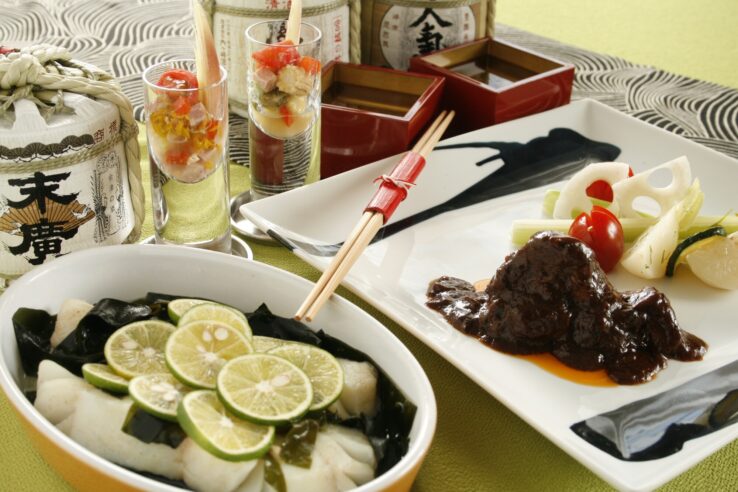Sake: The Art of Pairing for the Discerning Drinker
Sake, the traditional Japanese rice wine, has been gaining popularity worldwide in recent years (and it’s becoming particularly popular in the US). But the history of sake dates back thousands of years, with records suggesting that it was first brewed in Japan over 2,000 years ago.
Sake-making has since become an art form, with skilled brewers using only the best rice and purest water to create a diverse range of flavors and aromas. But what about pairing sake with food? While many people may think of sake as a drink to be enjoyed on its own, it can be a fantastic accompaniment to various dishes.
From sushi and sashimi to grilled meats and even cheese, the intricate flavors of sake can uniquely enhance the flavors of different foods. And that’s what we’re here to teach you — how to become a better sake drinker. Based on our sake courses and educational materials, we’ve sourced some tips for you on food pairings.
Follow along as we delve deeper into the world of this delicious Japanese rice drink and explore some of the best foods to eat with sake to impress even the most discerning of drinkers. You don’t have to be a sake professional to enjoy this bite-sized sake education.
What is Sake?
First thing first: what is sake? Sake, known as nihonshu in Japan, is a traditional Japanese alcoholic beverage made from fermented rice. While some may compare it to wine, sake has a unique flavor and production process that sets it apart.
The brewing process includes polishing the rice grains to remove the outer layers, washing, steaming, and fermenting it with a special sake yeast. The result is a variety of sake that ranges from sweet to dry, with different aromas and textures.
Sake is usually served in small ceramic cups or glasses and often paired with sushi, sashimi, or other Japanese dishes. Whether you’re a seasoned drinker or a curious beginner, sake is worth trying. However, learning how to drink it correctly and how to pair sake with food can elevate the flavors to new heights.
Tips for Drinking Sake
Drinking sake can be an incredibly enjoyable experience for anyone who appreciates the art of pairing. However, it’s important to note that the etiquette and serving glasses differ from what you might be used to if you’re more familiar with wine drinking. Actually, when it comes to sake vs. wine, they’re quite different.
Firstly, it’s essential to check if the sake you’ve been given is hot or cold. Sake that’s traditionally served cold will be put in a small glass or porcelain bottle. In contrast, a small decanter with a warming sleeve is usually utilized for hot sake (kanzake). Etiquette-wise, it’s recommended that you wait for the person who poured your sake to finish pouring theirs before taking a sip.
Again, sake vs. wine is a common topic of discussion, and it’s vital to note the crucial differences between the two. While wine is typically served in larger glasses that allow for swirling and sniffing, sake glasses are smaller and don’t require the same aeration. Sake is meant to be sipped rather than gulped, and this makes it an ideal pairing for food.
Overall, the key thing to remember when drinking sake is to savor each sip and appreciate the unique flavors and aromas that each bottle provides. By doing so, you’ll be better able to appreciate the art of pairing and become a discerning sake drinker!
How to Pair Sake with Food
Pairing food with sake is a true art. That’s the case for any alcohol and food pairings, honestly. However, sake’s strength and unique flavor make it difficult to pair for those new to the art of drinking sake. But it doesn’t have to be difficult! Here are some simple tips for foods to eat with sake.
Sashimi
Sashimi, or raw fish, is a great pairing for sake. The delicate flavor of the fish is complemented by the smooth, clean taste of sake. Pairing sashimi with junmai sake works well, as the sake’s richer flavor balances the fish’s subtle taste.
Another great option is to pair sashimi with a colder sake, which helps to bring out the refreshing taste of the fish. Some popular choices include ginjo and daiginjo sakes. Whatever your preference, be sure to choose a sake that balances the flavor of the fish and enhances your dining experience.
Steamed Lobster
Steamed lobster is a luxurious dish that pairs well with bold, full-bodied sake. The sweetness of the lobster is balanced by the sake’s rich flavor, creating a truly decadent dining experience. One great option is to pair lobster with honjozo sake, which has a smoother taste and brings out the sweetness of the seafood.
Another option is to choose junmai sake, which has a more robust flavor that complements the lobster’s rich taste. Whichever sake you choose, be sure to serve it chilled to really bring out the robust, buttery flavors of the lobster.
Cured Meats & Cheese
Cured meats and cheese are savory, rich foods that pair well with a light, crisp sake. A great choice for pairing with cured meats and cheese is a dry, fizzy sake, such as sparkling sake. The sake’s effervescence cuts through the richness of the meat and cheese, creating a delightfully refreshing experience.
Another option is to pair these foods with junmai ginjo sake, which has a milder flavor that complements the savory taste of the meat and cheese. So go ahead, and indulge in your favorite charcuterie board and sake combination (we guess that’s one thing sake and wine have in common).
Warm Apple Tart
For dessert, a warm apple tart pairs well with sweet, fragrant sake. Choosing a sake with fruity notes, such as plum sake or yuzu sake, enhances the apple’s natural sweetness and creates a harmonious flavor profile.
Another option is to choose nigori sake, which has a creamy texture that pairs well with the tart’s flaky crust. Be sure to serve the sake at room temperature or warm it up slightly to bring out its natural flavors.
Learn to Become a Better Sake Drinker
Pairing sake with the right food can completely elevate your dining experience. From sushi to grilled meats and even dessert, there is a sake variety that complements every dish. Learning about the different types of sake can help you become a better sake drinker or even a skilled sake professional. That’s where our Sake Adviser Certification Course comes in.
Our course is suitable for anyone eager to expand their knowledge of sake, whether you work in the hospitality industry or just love to drink it. We dive deep into the history and production of sake, as well as teach you how to properly serve and pair it with food.
Don’t miss out on this exceptional opportunity to become a true sake enthusiast and participate in high-quality sake education. Sign up for our Sake Adviser course now and start exploring the fascinating world of sake today!


